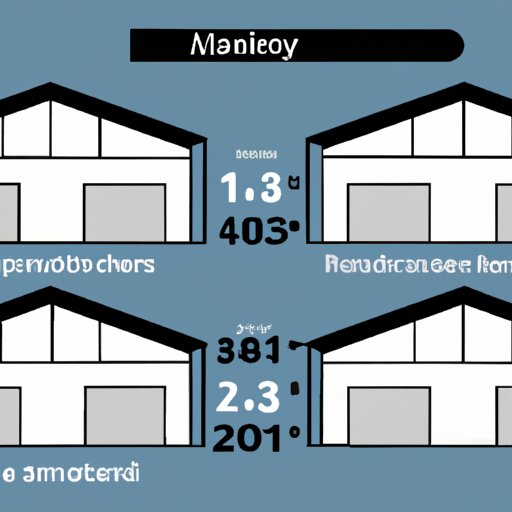Introduction
If you’re considering renting a warehouse for your business, you’ll need to understand the associated costs. Knowing the average rates for different sizes and types of warehouses is essential for budgeting and ensuring you get the best value for money. This article will explore the typical cost of renting a warehouse and discuss the factors that impact prices.

Exploring Typical Warehouse Rental Costs
The cost of renting a warehouse can vary greatly depending on several factors. These include the size and type of warehouse, its location, and the services included in the rental agreement. Let’s look in more detail at each of these factors.
Factors That Impact Warehouse Rental Prices
When it comes to renting a warehouse, size matters. Smaller warehouses tend to be more affordable, while larger warehouses may come with additional features such as loading docks, offices, and security systems. Similarly, the type of warehouse can influence the price. For instance, a cold storage warehouse will typically cost more than a regular warehouse due to its specialized construction.
Location is another factor that affects warehouse rental prices. Warehouses located near major transportation hubs or in urban areas tend to be more expensive, while those in rural areas may offer more competitive rates. Additionally, local regulations and tax incentives can have an impact on rental prices.
Average Rates for Different Sizes and Types of Warehouses
On average, warehouse rental costs range from $0.30 to $1.50 per square foot per month. The cost of a smaller warehouse (less than 10,000 square feet) typically falls within this range, while larger warehouses (more than 50,000 square feet) may cost up to $3.00 per square foot per month.
When it comes to type, cold storage warehouses tend to be more expensive than regular warehouses. The cost of a cold storage warehouse typically ranges from $0.60 to $2.00 per square foot per month. Other specialized warehouses, such as hazardous materials warehouses, may cost even more.

Comparing Warehouse Rental Rates in Different Locations
Rental rates for warehouses can vary significantly depending on their location. In general, warehouses located in urban areas tend to be more expensive than those in rural areas. Additionally, some states and cities offer tax incentives for businesses that rent warehouse space, which can help offset the cost.
Regional Variations in Warehouse Rental Prices
Warehouse rental prices can differ significantly from one region to another. For example, warehouses in the Northeast tend to be more expensive than those in the Midwest. Similarly, warehouses in California tend to be more costly than those in other states.
Investigating Local Regulations and Tax Incentives
Before signing a warehouse rental agreement, it’s important to research local regulations and tax incentives. Some cities and states offer tax credits and deductions for businesses that rent warehouse space. Additionally, some municipalities impose restrictions on the type of activities that can take place in a warehouse.

Examining Factors that Impact Warehouse Rental Prices
Understanding the various factors that impact warehouse rental prices can help you make informed decisions about where to rent a warehouse. Let’s take a closer look at these factors.
Understanding the Cost Breakdown of Warehousing Services
Warehousing services typically consist of three components: storage, handling, and distribution. Storage costs refer to the cost of renting the actual warehouse space. Handling costs refer to the cost of receiving, storing, and shipping goods. Distribution costs refer to the cost of delivering goods to customers.
Investigating How to Reduce Warehouse Rental Costs
There are several ways to reduce warehouse rental costs. One option is to negotiate a lower rate with the landlord. Another option is to look for warehouses in less expensive locations. Additionally, you can look into shared warehousing solutions, which involve sharing a warehouse with other businesses.
Assessing the Pros and Cons of Leasing vs. Buying a Warehouse
Another important consideration when deciding on a warehouse is whether to lease or buy. Each option has its own advantages and disadvantages. On the one hand, leasing allows you to avoid the upfront costs associated with buying a warehouse. On the other hand, buying gives you greater control over the space and allows you to build equity.
Advantages and Disadvantages of Both Options
Leasing a warehouse offers flexibility and requires minimal upfront costs. However, it also means that you don’t own the space and could be subject to rent increases. Buying a warehouse provides more control but involves higher upfront costs and a longer-term commitment.
Uncovering Hidden Costs of Warehouse Rentals
It’s important to be aware of any hidden costs that may be associated with renting a warehouse. These can include insurance costs, maintenance fees, and administrative costs. Additionally, you may be responsible for taxes and utility bills.
Conclusion
The cost of renting a warehouse can vary greatly depending on several factors, including size, type, and location. Average rates for different sizes and types of warehouses range from $0.30 to $3.00 per square foot per month. Additionally, there are regional variations in warehouse rental prices and local regulations and tax incentives that can impact the cost. Understanding the various factors that affect warehouse rental prices can help you make an informed decision about where to rent a warehouse.
Finally, it’s important to consider the pros and cons of leasing versus buying a warehouse. Leasing offers flexibility and requires minimal upfront costs, while buying provides more control but involves higher upfront costs and a longer-term commitment. Be sure to investigate any hidden costs associated with renting a warehouse.
By understanding the typical cost of renting a warehouse and exploring the various factors that impact prices, you can make an informed decision about where to rent a warehouse that meets your needs and budget.
(Note: Is this article not meeting your expectations? Do you have knowledge or insights to share? Unlock new opportunities and expand your reach by joining our authors team. Click Registration to join us and share your expertise with our readers.)
